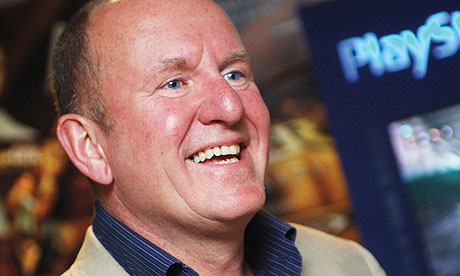Ian Livingstone CBE is an English fantasy author and entrepreneur. Along with his friend Steve Jackson, he is the co-founder of the popular and influential series of "Fighting Fantasy"roleplaying gamebooks and the author of many books within that series. He is also one of the co-founders of the prominent games company "Games Workshop".
Livingstone co-founded "Games Workshop" in early 1975 with flatmates John Peake and Steve Jackson. They started publishing a monthly newsletter tilted "Own and Weasel", and sent copies of the first issue to subscribers of the recently defunct fanzine "Albion", Brian Blume received one of these copies and so sent them a copy of the new game "Dungeons and Dragons" in return. Livingstone and Jackson felt that this game was more imaginative than anything being produced in the UK at the time, and so worked out an arrangement with Blume for an exclusive deal to sell "Dungeons and Dragons" in Europe.
In the late 1975, Livingstone and Jackson organised their first convention, the first "Games Day". While selling game products directly out of their flat, their landlord eventually evicted them after people kept coming to the property looking for a store that did not exist. But while they were living in a tiny trailer, the two were expanded "Games Workshop" from being a bedroom mail order company to a successful gaming manufacturer and retail chain, with the first store opening in Hammersmith in 1977.
Sadly in 1976, Peake, who had no interest in the new role-playing game industry, saw that "Games Workshop" was getting more involved with RPGs and decided to leave the company.
In 1980, Livingstone and Jackson began to develop the concept of the Fighting Fantasy game book series, the first volume of "Fighting Fantasy" was published by Puffin in 1982. While the two co-wrote the first book together in the series, the pair began writing subsequent books separately upon receiving instruction from publishers "Penguin" to write more books faster.
In the mid 1980s, Livingstone did some design work for video game publisher Domark, and in 1993, he returned to the company, this time as a major investor and board member. In 1995, Domark was acquired by the video technology company Eidos plc, which formed the major part of the newly created Eidos Interactive. In 2005, Eidos was taken over by SCi and Livingstone was the only former board member to be retained, taking on the role of product acquisition director.
Livingstone secured many of the company's major franchises, including "Tomb Raider" and "Hitman". He has especially been with the former series since the very beginning, proudly watching as it became the huge commercial success it is today.
More recently, the Livingstone Foundation is trying to gain permission from the government to build a publish school in Hammersmith that would specialise in teaching 800 students aged 11-18 STEAM: Science, Technology, Engineering, Art and Mathematics. The idea emerged as Livingstone, then Life President of Eidos, launched the next Gen skills campaign, which successfully lobbied government to add computer science to the national curriculum. If the Livingstone School is approved, it should open next year and begin teaching kids not just how to use technology, but how to create with it as well!
Livingstone wants to teach computer science to the next generation in a different way. He wants to move away from what he calls the "Victoria broadcast model of talk and chalk" to "actual learning". This, he says, is essential to the UK's economy, digital future and, hopefully, the video game industry. "We're educating children for jobs that don't even exist today".
Despite the fatigue I was experiencing that day as I rushed to meet a deadline for a certain school module (Same old, same old...), I really did find myself enjoying this talk and frankly found it to be rather different to the past ones I had attended. I thought it was a splendid idea that he is planning to open a school for children that teaches computer science, and I suppose I envy those children once they get the chance to enrol there.
Honestly all I really knew about Ian Livingstone before I attended this talk was his involvement with the "Tomb Raider" series, but it is pretty amazing to know how much he has contributed to the game industry over the last few decades, I am even tempted to pick up a few of those "Fighting Fantasy" books now.




































